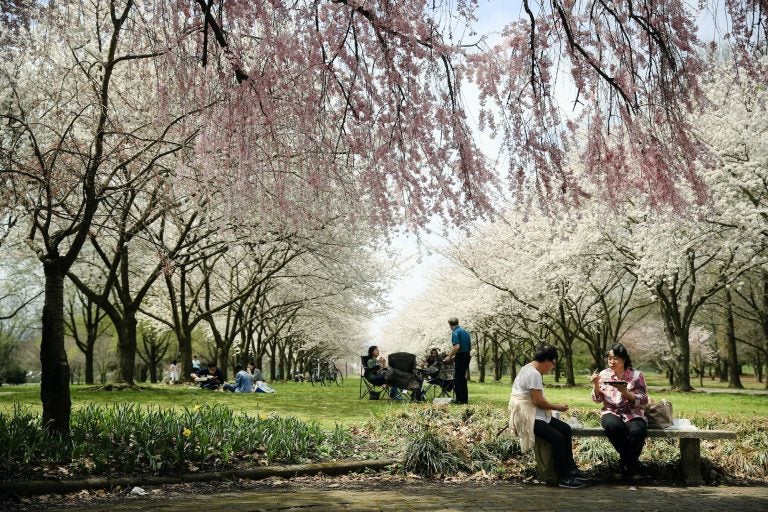Climate change and the rise of seasonal allergies
Listen
People picnic amongst trees blooming with flowers on a warm spring afternoon at the Fairmount Park Horticulture Center in Philadelphia, Monday, April 8, 2019. (AP Photo/Matt Rourke)
Experts say allergy symptoms are getting worse each year and larger environmental issues could be a factor.
If even hearing the word “ragweed” makes your eyes water, you might be one of the nearly 45 million Americans with seasonal allergies. And allergists say the number of people with sensitivities to Ragweed and other plants is growing. As it turns out, the rise in allergies and asthma is fueled by climate change.
Jenny Fischer has been taking over-the-counter medication for allergies for a long time. Without it, she suffers cold-like symptoms: a runny nose, sneezing and congestion. An allergy pill usually made it better. But a couple of years ago, things started to get worse.
“I’d be out at 5:30 in the morning walking my dog, and it would just be huffing and puffing. And, you know, I couldn’t catch my breath. It’s scary,” she remembers.
Her doctor, David Skoner, diagnosed her with asthma. Like many allergists he’s seeing more patients with allergies, and those allergies are getting more severe. Skoner spends his lunch hour filling out new prescriptions. According to him, “the number of patients calling in for allergies has just skyrocketed.”
The American College of Allergy, Asthma and Immunology says a top reason for that is climate change. Higher temperatures and carbon dioxide levels are affecting plants, and that’s leading to more allergies.
Immunologist Asha Patel walks up to the roof of Allegheny General Hospital in Pittsburgh every morning to take pollen counts. She uses a machine called a Spore Trap. It looks kind of like a small weather vane. And Patel says it pulls in air like a large nose.
“There’s a suction created. So it draws the air through this opening right here, and the sample is collected inside,” she explains.
Patel takes a glass microscope slide out of the spore trap. It’s the one she put in yesterday. And it’s covered with speckles. She takes it down to the lab and dots on pink dye. Under the microscope, she watches as a perfect circle emerges. She says it’s the pollen from a common weed. “Here’s the English Plantain, it’s one of the weeds,” Patel points out.
Researchers do this kind of pollen collection all over the country, and they’ve seen trends emerge. Dr. Leonard Bielory of Rutgers University has been studying the connection between pollen levels and the throngs showing up at his office. “I saw a hidden signal in the pollen count changing over time,” he says. “And I started correlating that we’re seeing patients earlier and the volume seems to be increasing. And some who were moderate or mild in years past are now more severe.”
In a study published by the National Academy of Sciences, Bielory and other researchers looked at a common allergen, ragweed, in the Midwest and Canada.
In Canada, they found the ragweed season was almost a month longer in 2009 than in 1995. Bielory says the ragweed season in our region is about five days longer than it was twenty years ago.
Researchers looking at the impacts of climate change also find that as carbon dioxide levels rise, the pollen is becoming more severe. Lewis Ziska is a researcher with the U.S. Department of Agriculture.”Just changing the CO2 from the early part of the 20th century to the latter part of the 20th century, for example, doubles the production of pollen from a single plant,” he says. “And there was some indication that it was a more allergenic pollen. That is, it was producing more of the proteins that people were allergic to.”
Researcher Leonard Bielory says the worsening pollen is especially dangerous for children who already have respiratory problems.
“And you will cause an inflammatory mix, or what I call the witches brew, where we have the temperature, ozone and pollen all mixed together, you will cause an incredible inflammatory response of the eyes, nose, and therefore in those who are more prone to it, the lungs as well, leading to more asthma,” he warns.
Bielory says on high pollen days people with respiratory problems can take over-the-counter medicine preventatively so itchy eyes and runny noses don’t turn into dangerous asthma.
The Allegheny Front is produced in Pittsburgh and reports on Pennsylvania’s environment.
WHYY is your source for fact-based, in-depth journalism and information. As a nonprofit organization, we rely on financial support from readers like you. Please give today.



